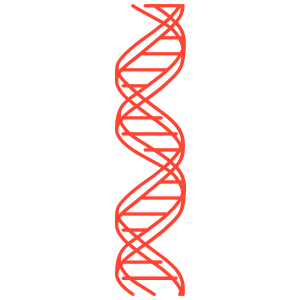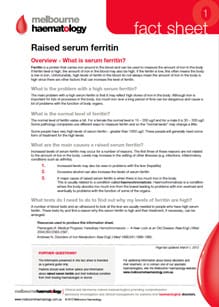Overview
Hereditary Haemorrhagic Telangiectasia (HHT or Osler-Weber-Rendu syndrome/disease) is an uncommon or rare inherited (genetic) disorder which is characterised by abnormal connections between arteries and veins – these connections are called “vascular malformations” or AVMs (arteriovenous malformations).
What causes Hereditary Haemorrhagic Telangiectasia (HHT)?
HHT is a genetic disorder – a change in the genes causes HHT. We inherit half of our genes from each of our parents. When a gene change occurs, there is the potential that this can cause problems with health. HHT occurs when there is a change in the genes that control the development of blood vessels.

HHT is an autosomal dominant disorder
– this means you only need one copy of the abnormal gene (i.e. from one parent) to develop HHT putting you at risk of developing AVMs.
What are AVM’s?
AVMs or arteriovenous malformations occur when an artery develops an abnormal connection straight to a vein. Normally blood travels from the heart in arteries and then gets to body organs and tissues by dividing into very small blood vessels called capillaries. The capillaries then drain into veins which carry the blood back to the heart. An AVM occurs when the blood travels straight from the arteries to the vein.
What are the problems with AVM’s?
The abnormal connection between the artery and the vein is often very fragile and can rupture or burst leading to bleeding into the tissues.
The type of symptoms that a ruptured AVM causes will depend on where the AVM occurs in the body.
- AVMs can occur in the skin (called telangiectasia), in the lining of the nose (can cause severe blood noses), in the brain (cause strokes) and in the lungs (cause bleeding into the lungs).
- Less commonly, AVMs can occur in the liver and the gastrointestinal tract.
Diagnosis
How is HHT and AVMs diagnosed?
HHT can be diagnosed by taking a careful family history to identify relatives who may have had HHT, by close examination to see if patients have AVMs and by specialised radiology or imaging studies to see if AVMs are present in organs in the body.
There is also specialised genetic test that can be performed to identify the gene changes that are responsible for HHT.
The type of specialised radiology tests for each of the different types of AVMs is listed below.
Specialised screening tests for the different types of AVMs

I have HHT and blood noses – what should I do?
Management of blood noses
The management of blood noses (epistaxis) in patients with HHT can be difficult. Epistaxis is very common in HHT with approximately 50% of patients with HHT experiencing epistaxis as a child / adolescent. Epistaxis is common in HHT due to the presence of abnormally fragile vessels in lining of the nose.
A number of treatments are available including keeping these blood vessels moist (e.g. humidification or applying a lubricant), minor surgical procedures to remove the blood vessels (e.g. cauterisation) or even applying a skin graft to the area to stop the bleeding (septodermoplasty).
It is important that the doctors dealing with the blood noses are familiar with HHT since some procedures can lead to more bleeding.
The aim of genetic diagnosis is to identify the specific gene change in the family.
- Genetic diagnosis involves sequencing the genes (ENG/HHT1 and ACVRL1 / HHT2).
- There are no common mutations with each family having a “private” HHT mutation.
- Approximately 75% of patients with clinical HHT will have a mutation identified using sophisticated gene testing.
Gene testing can be expensive and it is best to discuss this with your doctor.
XXXXX
How common is Hereditary Spherocytosis (HS)?
HS is relatively common – around 1 person in every 5000 people has HS (around 800 people in Melbourne; population 4 million).
in 5000 people has HS
people in Melbourne
population of Melbourne*
What does having HS mean?
There are three main common problems associated with having HS:
There is another uncommon potential problem for people who have Hereditary Spherocytosis associated with a viral infection called “Slapped cheek”. Slapped cheek is caused by a virus called Parvovirus which can infect bone marrow cells and put the red cell producing cells “to sleep”. Because patients with HS need the bone marrow to be rapidly replacing the fragile red cells, this infection can cause a severe anaemia; patients can become very pale and sometimes even require blood transfusions. Fortunately this problem is uncommon.
Diagnosis
How is Hereditary Spherocytosis diagnosed?
HS is now diagnosed with a simple blood test. It is also important for a doctor to examine patients with HS to see if they are jaundiced or have an increase in the size of the spleen.
Treatment & Management
What do I need to do now that I (or my child) has been diagnosed with Hereditary Spherocytosis?
Most patients with HS do not need to do much about their condition at all. The bone marrow has the capacity to increase the number of red cells it produces many fold and is able to keep up replacing the fragile cells.
A few things may be helpful:
Will I (or my child) need a splenectomy?
Removing the spleen (splenectomy) has been used a lot in the past in the treatment and management of patients with HS; it stops the red cells from breaking down and solves the problems of HS.
Removing the spleen has problems however – the spleen is an important organ in the immune system and patients who do not have a spleen may be prone to getting serious infections. This risk is higher in younger children but may be less than previously expected because of newer vaccinations. It is now generally recommended to avoid splenectomy in children younger than 6 years and to ensure that children who may need a splenectomy have all the appropriate vaccinations.
Another approach for some of these young patients is to remove only a small part of the spleen – partial splenectomy. This is done in a few hospitals and there is some experience to say this may be very helpful for some patients.
Resources used to produce this information sheet.
- Faughnan ME, Palda VA, Garcia-Tsao G, et al. International guidelines for the diagnosis and management of hereditary haemorrhagic telangiectasia. Journal of Medical Genetics. Feb 2011;48(2):73-87.
- Govani FS, Shovlin CL. Hereditary haemorrhagic telangiectasia: a clinical and scientific review. European journal of human genetics : EJHG. Jul 2009;17(7):860-871.
Further Questions?
The information presented in this fact sheet is intended as a general guide only.
Patients should seek further advice and information about Hereditary Haemorrhagic Telangiectasia and their individual condition from their treating haematologist or doctor.




